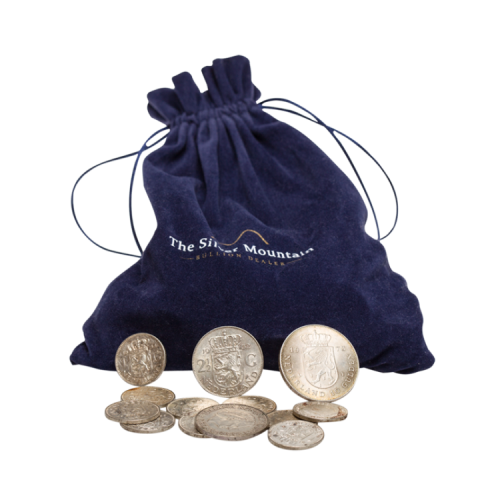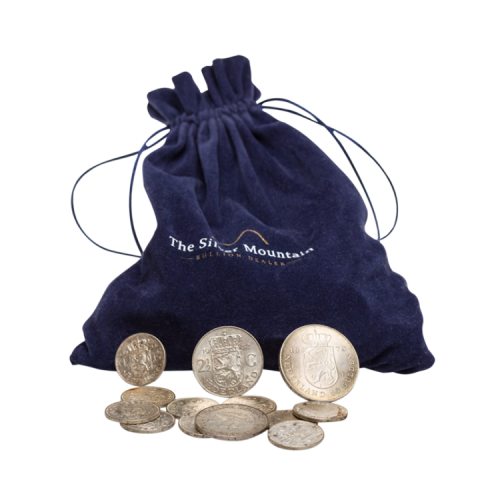- On sale
- Pre-owned

 In stock
In stock
- On sale
- Pre-owned

 In stock
In stock
- On sale
- Pre-owned

 In stock
In stock
Buy Dutch silver coins
Dutch silver coinage comes in various forms. The most well-known are, of course, the guilder and the euro, but our country has a rich history when it comes to coinage. One of the most beloved coins, which we no longer use, is the rijksdaalder. Since 2002, we have been using euros in the Netherlands. Until then, the guilder was the official currency.
Over the years, many Dutch coins have been issued, including some unique series. Among the more unique Dutch coins are the silver rijksdaalder, the silver ten-guilder coin, and the gold ten-guilder coin. In addition to standard Dutch coinage, we also have several special commemorative coins issued in honor of important people or events. At The Silver Mountain, you will also find Dutch coinage, primarily in the form of silver coins.
Weight and content of Dutch coins
Dutch silver coins vary in weight and silver content depending on the year of issue and type of coin. Nineteenth and twentieth-century Dutch guilders typically contain 72% silver, while certain commemorative coins often contain over 90% (sterling) silver.
The Dutch silver rijksdaalder is one of the most cherished Dutch silver coins. Rijksdaalders minted before 1943 are composed of 72% silver and weigh 25 grams gross. Rijksdaalders minted from 1959 to 1966 also have a silver content of 72%, but weigh only 15 grams gross. Another notable coin is the silver tientje, a commemorative coin issued between 1970 and 2001. Coins from 1970 to 1973 contain 72% silver and weigh 25 grams gross, while those minted after 1994 are made of 80% silver and weigh 15 grams gross. The value of Dutch silver coinage is heavily influenced by its silver content.
Accordingly, we sell Dutch silver coinage in bags based on the net weight of silver. All these coins are minted with a 72% silver content, and depending on market conditions, customers can purchase bags weighing one kilogram, two kilograms, or five kilograms of Dutch coinage.
For your reference, the gross weight of a one-kilogram bag of Dutch coinage is 1,390 grams, which equates to one kilogram of pure silver (1,390 x 0.72 (72%) = 1,000 grams).
The table below lists the different coins. Description Year Weight Content silver 1/2 Gulden 1857 up to 1919 5 grams 94,5% 1/2 Gulden 1921 up to 1930 5 grams 72% 1 Gulden Before 1945 10 grams 72% 1 Gulden 1954 up to 1967 6.5 grams 72% Rijksdaalder before 1943 25 grams 72% Rijksdaalder 1959 up to 1966 15 grams 72% 10 Gulden 1970 up to 1973 25 grams 72% 10 Gulden 1994 15 grams 72% 10 Gulden 1995 up to 1999 15 grams 80% 50 Gulden 1982 up to 1998 25 grams 92.5%
Dutch coin collecting market
Dutch coinage plays a significant role in the collecting market. Collectors value various aspects of Dutch coins, such as historical significance, condition, and rarity. Additionally, the story behind each silver coin adds to its appeal.
The market for Dutch coin collecting is diverse, with coins of high historical value generally being the most sought after, especially when they are in excellent condition. These coins include special commemorative issues as well as coins from the Dutch Golden Age. The Dutch coin collecting market is also versatile, with collectors finding opportunities at auctions, fairs, and online platforms.

Dutch silver coins as an investment
Dutch silver coins can be an interesting investment option. A significant advantage of investing in silver coins is that one can benefit from both their numismatic (collectible) value and the intrinsic value of silver. This dual potential can lead to an increase in the coin's value through both rising collectible demand and rising silver prices.
At The Silver Mountain, you are in the right place if you are interested in investing in Dutch silver coins. We ensure a reliable investment, with all coins carefully selected and rigorously checked for quality and authenticity.
Frequently Asked Questions about Dutch Coinage
Which Dutch coins are most valuable?
The value of Dutch coins is influenced by various factors, including their historical significance, condition, and rarity. Some of the most valuable Dutch silver coins include rare variants of the silver guilder and rijksdaalder, as well as certain commemorative coins. The gold ten-guilder coins from the nineteenth and twentieth centuries are among the most valuable Dutch gold coins. At auctions, Dutch coins can sometimes sell for significant amounts, with collectors focusing on the condition and rarity of the coins. For instance, in 2016, a silver guilder from 1867 was sold at auction for more than 100,000 euros.
At The Silver Mountain, the value of the coins is determined by their content and weight, which reflects their precious metal value. Dutch silver coins are packaged in bags of 1, 2, or 5 kilograms and sold at a slight premium over the silver price. Among the Dutch coins we offer, the gold double ducat is the most valuable.
What is the cost of a kilogram of Dutch silver guilders?
The price of a kilogram of silver guilders is linked to the current silver price. All prices on our website are continuously updated to reflect the latest silver prices. One kilogram of silver guilders corresponds to 720 grams of pure silver, as silver guilders and other Dutch coins, such as the rijksdaalder and ten-guilder, are minted with 72% silver.
We sell silver guilders, rijksdaalders, and ten-guilders in bags containing a mix per kilogram of pure silver. Compared to the silver price, you pay approximately a 10% premium, meaning you pay 10% more than the silver value of the coins. At the time of writing, a kilogram of silver is valued at approximately EUR 850.
In what condition is Dutch coinage?
Dutch coinage was previously in circulation as legal tender. This may result in the coins showing minor signs of wear or discoloration. However, the condition of the coins is generally good to very good. This is because Dutch coinage was minted with 72% silver, and this relatively low silver content ensures that the coins are durable and less prone to damage. The coins are traded based on their silver weight, which means that when you resell the silver, the state of the coins does not affect the price offered.
When filling bags with Dutch coinage, we aim to provide a mix of silver guilders, rijksdaalders, and ten-guilders, depending on market conditions and the inventory we receive. In some cases, the mix may even include pre-war coins, such as half silver guilders.
Can I sell Dutch silver coins back?
You can certainly resell your purchased Dutch silver coins to us. You can take advantage of our buyback guarantee for reselling. Through our other website, Inkoop Edelmetaal, you can sell coins to us.
We purchase Dutch coinage individually or in bags of 1, 2, and 5 kilograms of pure silver. Our offer price is always based on the most current silver price, and we pay 95% of the prevailing silver price. Dutch coinage is well-known within the Netherlands and is a common product for us. Please note that outside the Netherlands, it may be less straightforward to sell these coins due to their relatively low silver content.


















